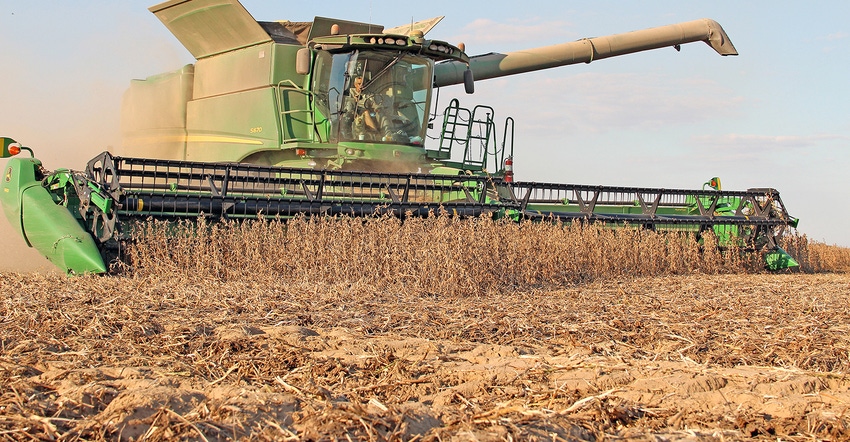February 27, 2019

When U.S. farmers planted more than 90 million acres of soybeans in 2017 — and nearly the same amount again last year — they had no idea their largest customer would be absent from the market for a large part of 2018.
The record acreage in 2017 and near-record in 2018, high yields and the ongoing U.S. trade dispute with China have put those farmers in a bind from which they won’t soon recover, says Dr. Terry Barr, senior director of industry research for CoBank’s Knowledge Exchange Division.
“We are talking about near record stocks to use and inventories in excess of 900 million bushels,” said Barr, who spoke during a University of Arkansas System Division of Agriculture Food and Agribusiness Webinar (https://bit.ly/2tAXdCG). “This is not going to be worked down any time soon.”
The 900 million bushels of U.S. ending stocks projected for 2018 is the highest level since carryover stocks of nearly 600 million bushels in 2006-07. U.S. ending stocks have reached that level only one other time: in 1985, when soybean prices fell to $4 per bushel.
“It’s (the 900 million bushels) going to overhang the market for the next couple of years unless we get major shifts in acreage,” said Barr. “I think this is going to be a several-year workout for these inventory levels. We will draw it down a bit next year.”
Much depends on how aggressively China comes back in the market, according to Barr. As this is being written, U.S. and Chinese representatives had agreed to extend their negotiations to try to arrive at an agreement resolving their trade dispute. (China placed 25 percent tariffs on U.S. soy imports in retaliation for U.S. tariffs on Chinese imports to the U.S.)
The record acreage in 2018 and near-record in 2019 aren’t the only reason for the buildup in stocks, according to Barr, who was a lead economist at USDA prior to leaving for a similar position at the National Council of Farmer Cooperatives in Washington.
“Obviously, mother nature has been fairly kind to agriculture if you look at the yields we are experiencing in the U.S. and outside of the U.S.,” he said. “Yield numbers have been strong in terms of corn and soybeans,” with corn climbing to an average of 176.4 bushels per acre last year and soybeans to 51.6 bushels per acre.
The U.S. economy has entered a period of significant change, he noted. “We have a slow economy with wide-ranging uncertainties. We have what you have to assume is an adequate supply of most commodities because mother nature has been kind to us.”
U.S. commodity prices have been trending lower since growers experienced the “super cycle” that took them to new heights between 2004 and 2011. They have yet to return to the levels of the late 1990s and early 2000s, fortunately.
More adjustments?
“Now we’re asking ourselves are we done with adjustments or do we have more adjustments to make?” Barr asked. “What is going to happen with input costs? We have a whole food and ag supply chain that’s really trying to find its footing in this new level of prices that we are talking about.”
This is also a difficult time to “try to define normal,” he noted. “When you look around the globe, you find no shortage of issues when talking about the Asian markets, the Korean Peninsula, whether talking about China or Japan or Russia or Middle East issues. We have problems with Brexit and with two big leaders probably stepping down in the not‑too‑distant future, and we have a U.S-Mexico Canada agreement that has not been ratified yet.”
Barr said China remains the centerpiece in terms of global demand, the force that will drive much of the rest of Asia. He believes the Chinese economy will continue to grow at the rate of about 6 percent per year.
“I think they are committed to an aggressive growth pattern in the next few years. With their centennial celebration coming in 2021, I expect China’s leadership will be driving that economy harder to get to that 100th anniversary of the Chinese Communist Party.”
If you look at U.S. agriculture, it’s more export dependent than it was before. Crops like soybeans, cotton, rice and tree nuts and most of the livestock sector have come to rely on exports for a much higher percentage of their sales.
That’s why perceptions are important in other countries. “We don’t know what consumers overseas are going to be doing with regard to their supply chains,” he said. “If they perceive the U.S. is a less reliable supplier because of policy issues, they are going to diversify supply. We will then get a better feel for how much market share we lost as a result of changing our position in the global arena. That’s when we can test what the cost really was of using a tariff approach.”
As far as the overall economy, “we are in longest business cycle in U.S. industry,” he said “Beginning in 2007, we had a much longer and deeper recession than we have had historically. Now we’ve been the longest expansion from the recession.”
He said he believes the expansion will continue, primarily because of consumer spending. “I don't see anything — absent a black swan event — that indicates we are near the beginning of a recessionary situation.”
For more on the University of Arkansas Food and Agribusiness Webinars, visit www.uaex.edu/ag-webinars.
About the Author(s)
You May Also Like






